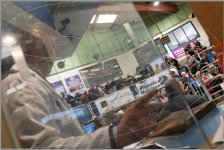I wonder if these 'masters of composition' consciously think about any of the academic explanations/deconstructions of what they've done when they're framing/arranging shots?
Firstly, I'm not sure that the books I listed would be considered academic. The reason I like them is that they are very practical, and reflect some of the points being made in the video that started this conversation. As examples the books discuss things like how you frame and light a shot to demonstrate that a particular person (among many) is in charge. Or, If you have a man and women at a table, how do you compose and light them to suggest this is a business meeting, a wedding anniversary or a first date. People like these authors who work at the top end of the film industry really are masters in telling stories and creating mood through composition.
But for your question, I don't there is an easy answer to that. I would argue that the explanation of why one picture works and another doesn't work as well as another, can be down to "composition". But by that I don't just mean the "placement" of the subject matter in the frame, but the balance of all the elements that a picture is composed of..
So, I don't think a "master of composition" can consciously think about applying all the nuances of academic explanations and deconstruction when they are framing/arranging shots, because it's too complicated and the composition "on the day" has to driven by the interaction between the subject, the artist and what the artist is trying to say.,
Rather, I think they are more likely to subconsciously, based on experience and previous analysis of what they have found to work and not work, compose instinctively. Not in the true meaning of instinct, but more in the sense of having enough experience to do something without thinking about it.
Edward Weston talked about adjusting his composition until he could hear a Bach fugue.
Cartier Bresson, who trained as a painter, wrote that he would analyse all his photographs after he had taken them (using Dynamic Symmetry principles) to work out why some worked better than others, but never consciously thought about composition while taking pictures.
In contrast to this, if you x-ray some of the paintings from master painters there are several (maybe many, I don't really know) where you can see they started the painting by drawing a dynamic symmetry grid on the canvas to guide the composition.
As I am no master of composition, I sometimes use the principles of dynamic symmetry "in the field" to try and help work out why I can't get a composition to feel right.



